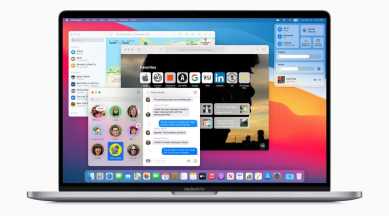Apple macOS Big Sur is now out: Six features to keep in mind
Apple's big software update for Macs, which is macOS Big Sur, is now officially available. MacBook Air, Pro, Mac mini and iMac users can go ahead and install the new update on their devices. A look at six new features.

Apple’s big software update for Macs, which is macOS Big Sur, is now officially available. MacBook Air, Pro, Mac mini and iMac users can go ahead and install the new update on their devices. macOS Big Sur brings the operating system closer to iOS in terms of features and design. Here’s a look at some new features, which stand out.
How to upgrade your MacBook
Apple says the following models are supported: MacBook (2015 or later), MacBook Air (2013 or later), MacBook Pro (Late 2013 or later), Mac mini (2014 or later), iMac (2014 or later), iMac Pro (2017 or later) and Mac Pro (2013 or later).
monthly limit of free stories.
with an Express account.
Apple also recommends that users need to make sure the following conditions are met before updating:
The MacBook or iMac is on OS X 10.9 or later, they have 4GB of memory and 35.5GB available storage on macOS Sierra or later.
Now go to the Mac symbol in the Menu Bar, followed by System Preferences followed by Software Update. You will find the macOS Big Sur update there. Click Upgrade Now, and follow the onscreen instructions.
Read more: Apple macOS Big Sur review: A much needed revamp
If you are running any release from macOS 10.13 to 10.9, you can upgrade to macOS Big Sur from the App Store. If you’re running Mountain Lion 10.8, you will need to upgrade to El Capitan 10.11 first, according to Apple.
Control Centre
This is a useful addition to that Big Sur brings to macOS. The Control Centre appears in the Menu Bar on top, and is similar to the one on iOS. So you can see the settings for Bluetooth, Display Brightness, Keyboard Brightness, Volume, WiFi, all from this one point. The feature makes it easier to find system settings on macOS.
Apple iPhone 12 review: A worthy retro homage to the iPhone 4
Redesigned and interactive notifications
Apple has also redesigned notifications in macOS Big Sur to bring them closer to how they appear on iOS. Widgets have been redesigned for notifications. But more importantly notifications are now interactive and you can choose to reply to a message or delete a mail straight from the notifications panel.
In the new operating system, notifications are grouped by thread or app. A user can expand each group to see earlier notifications. You can also disable grouped notifications from the settings.
Memoji on Macs
Apple is also bringing Memojis to Macs. If you still have an older iPhone and have not tried out the Memoji feature, you can now do so on your Mac as well. Memoji lets users express themselves in more fun ways; it has been a part of iOS for a while now.
Expressive Messaging for festivals, including Indian ones
Apple is also adding expressive messaging for festivals to Messages on Macs. This is also being extended to Indian festivals. The feature is already available on iOS. So when you wish someone Happy Diwali or Happy Holi on Messages, the app will have an animation go off in the background. In Diwali’s case it is fireworks, and looks really nice. The feature will work for 23 Indian languages.
Optimized Battery Charging and usage history
This also comes from iOS and is a much needed and useful feature, though it is limited to Macs with Thunderbolt 3 ports. With the Optimized Battery Charging, the OS learns your daily charging routine and this gets activated when it predicts the Mac will be plugged in for a longer period. The idea is to reduce the wear on your battery and improve its lifespan.
This is important given many of us are working from home and might leave the Mac plugged in for a long time. There’s also a new Battery usage history, which displays graphs of battery level and usage for the past 24 hours and the past 10 days.
Photos app and video editing
Apple is bringing some of the video editing features we’ve seen on iOS to macOS Big Sur. Users will be able to apply adjustments, filters, and crop their videos in the Photos app. Earlier, these options were limited to photos. Users will also be able to rotate, increase exposure and apply filters to their videos.
One more thing: New fonts for India
Apple is also bring 20 new document fonts for India. In addition, 18 existing fonts have been upgraded with more weights and italics for more choice.